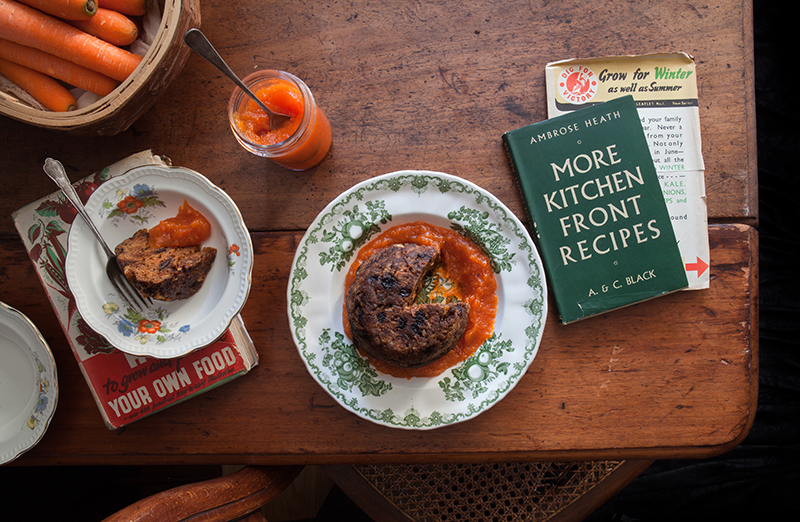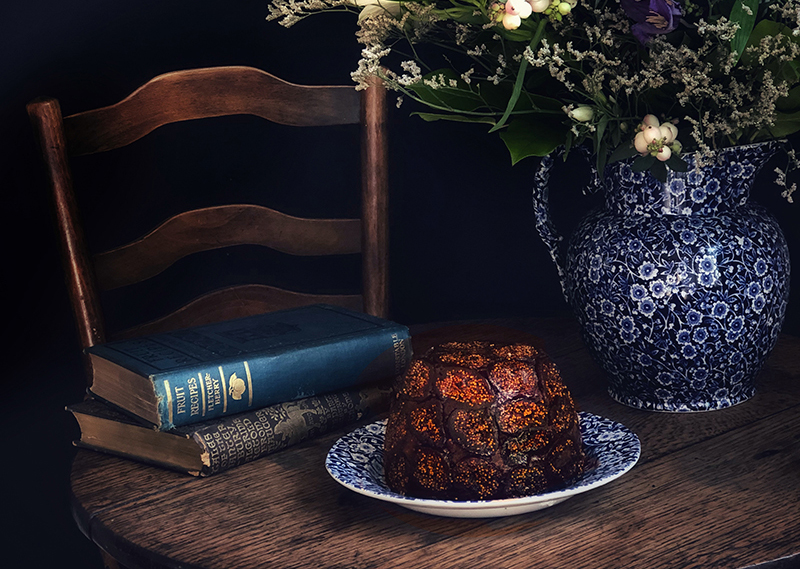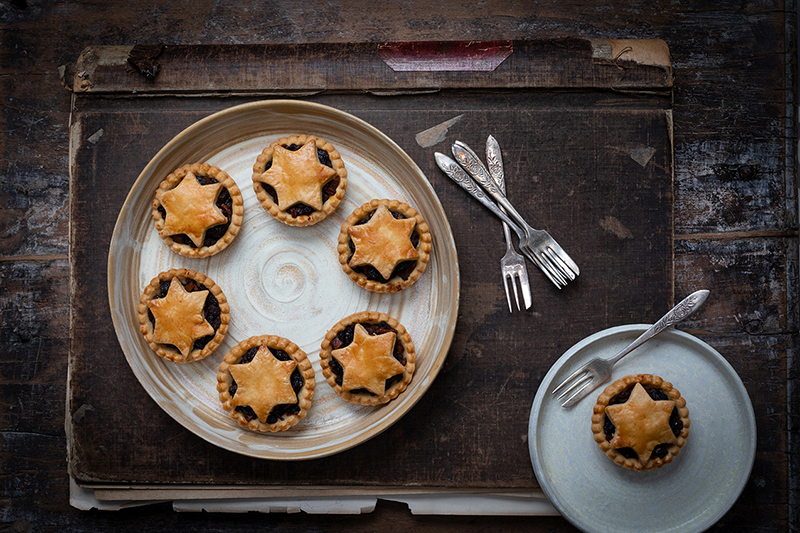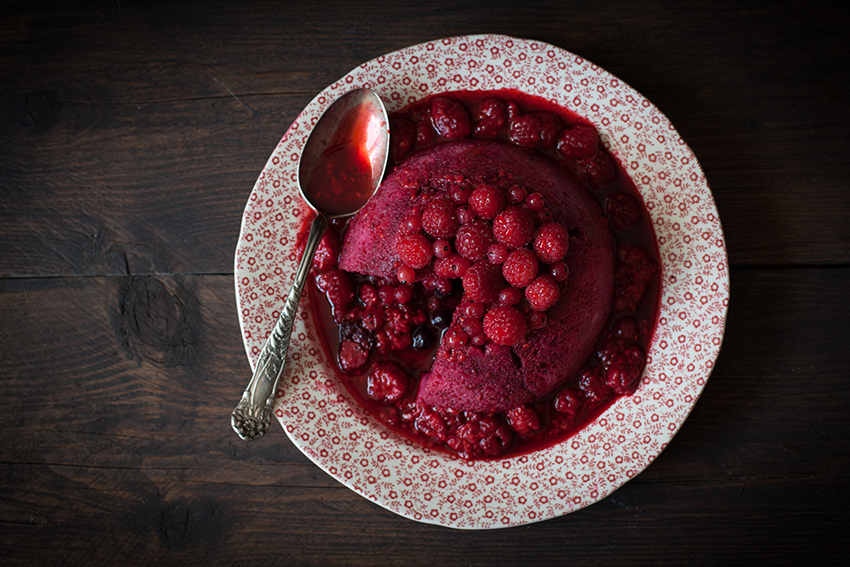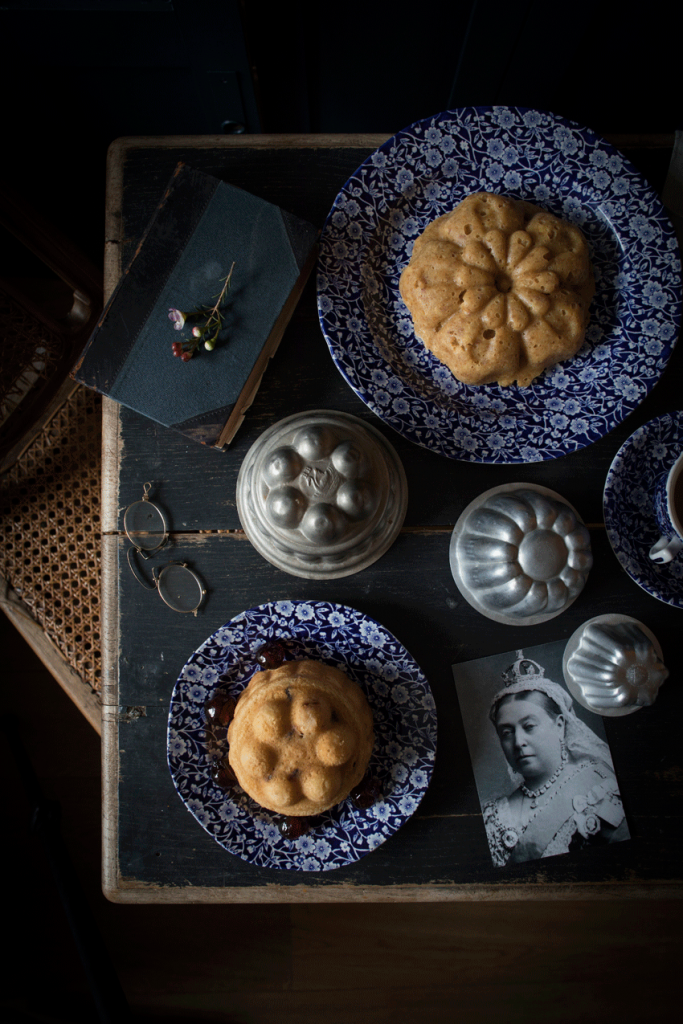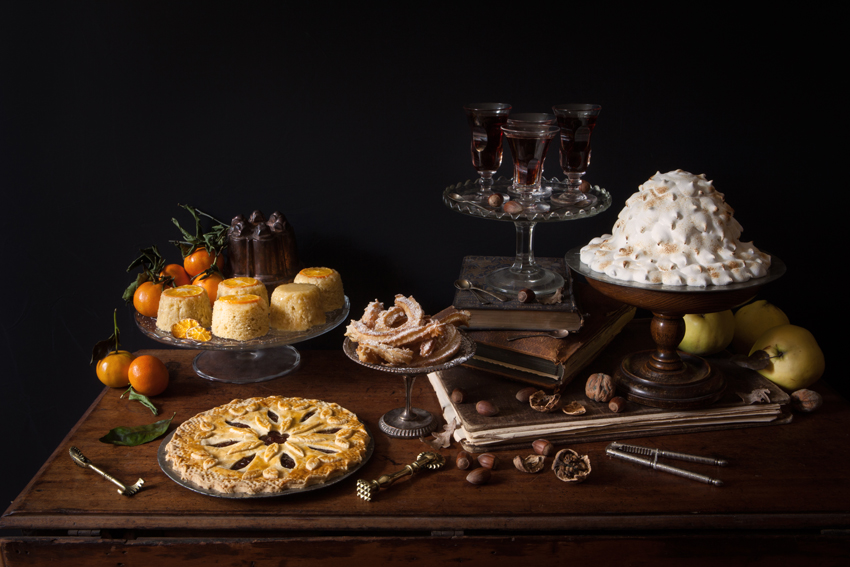Today 8 may I’ll be showing two war-time recipes over at London’s Borough Market for the 75th anniversary of ‘Victory in Europe Day’ or the end of WWII.
While world wars and lockdown are very different, both have led to difficulties obtaining certain ingredients. We’ll be looking at two war-time recipes that were actually promoted by the Ministry of Food because there was an overload of carrots and potatoes. Recipe booklets were made to help cooks to whip up a variety of recipes with carrots and potatoes and other austere but often very delicious creative recipes…
Historical recipes
Jaune Mange
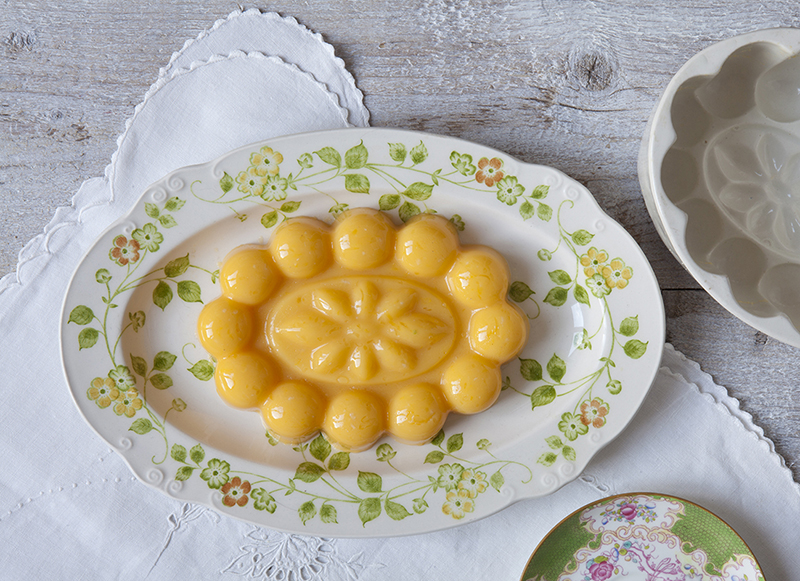 Jaune Mange jelly is the yellow sister to the ancient delicacy called Blanc Mange which means ‘white food’. It is one of the most international early dishes of European cuisine. From the Middle Ages onwards the name of this dish in its various forms – blanc mange, blanc manger, blamange, manjar branco, biancomangiare – can be found in most European cookery books.
Jaune Mange jelly is the yellow sister to the ancient delicacy called Blanc Mange which means ‘white food’. It is one of the most international early dishes of European cuisine. From the Middle Ages onwards the name of this dish in its various forms – blanc mange, blanc manger, blamange, manjar branco, biancomangiare – can be found in most European cookery books.
It is believed by many food historians that the earliest recipe for blancmange dates back to the twelfth century. Two recipes for blancmange also feature in the earliest English cookery text, The Forme of Cury from C1390. By 1395, two recipes for blancmange can be found in the Viandier manuscripts, the first French cookbook: one is a dish for the sick, the other is a multicoloured dish, which is at odds with the name’s literal meaning.
This recipe uses seville orange juice, while others recommend lemon and lemon peel for flavour and colour. Later recipes by J.H. Walsh in The British Cookery Book (1864) instruct the cook to use sherry or ‘raisin-wine’. Because the eggs give this jaune mange a set already, you don’t need to use as much gelatine as you would for a blancmange.`…
Figgy Pudding for my ‘National Trust Book of Puddings’
Today is Stir-up sunday and the most important day on the pudding calendar. Today is the day to prepare the Christmas pudding, or plum pudding. Why this should be done a month before Christmas is something I’ve written about in a previous posting here and in my book Pride and Pudding. But this year I wanted to give you an alternative to the traditional plum pud.
A figgy pudding is just another name for a plum pudding – and both of them generally refer to puddings made with raisins or currants and no figs at all. However there have been recipes for figgy pudding in the late 19th century, but those recipes did refer to puddings made with figs and didn’t give a recipe for plum pudding. Using dried figs, this results in a dark and luxurious winter pudding. Why not have this as your pudding on Christmas day for a change this year?
This is a recipe from my little book the ‘National Trust Book Of Puddings‘ which was published in april (2019)….
When it comes to Mincemeat, you have to plan ahead
Mincemeat is an ancient recipe that gives you a taste of Medieval times gone by when the usage of this mixture was widely common for sweet as well as savoury dishes. That is if you were well off, dishes with these rich ingredients were the privilege of the very rich and one of the first recipes dates from the 14th century scroll presumably written by the chef of King Richard II.
Mincemeat is best made at least a month in advance so that the flavours can mature. You can use it for different recipes: as a filling for Mince pies of course but also for Eccles cakes and a couple of other British bakes.
The combination of fruits and spices for mincemeat is often diverse, but raisins, currants and candied lemon, cedro and/or orange peel are standard. Some old recipes also contain prunes, dates, figs or candied ginger. Spices are usually cinnamon, cloves, mace and nutmeg. There is always grated apple or pear and sometimes also lemon or orange juice – mostly from Seville oranges (these are very acidic and also the basis for English marmalade – see recipe here).
You can make the mincemeat in this large quantity and store it in the fridge for up to 6 months in sterilised preserving jars.
And then for a little joyeus news: my new book ‘Brits Bakboek‘ has been nominated for ‘Het Gouden Kookboek’ a prestigious kookbook award in the Netherlands. I’m absolutely chuffed and honoured to be nominated as the only Belgian on the list!
…
Hot Cross Buns – The Tale Of English Buns # 2
 Bake them on Good Friday: The history and tales behind these spiced buns are plenty and intriguing, steeped in folklore dating back as far as Anglo-Saxon Britain. This is perhaps one of the most iconic of buns. Recipe from my new book Oats in the North, Wheat from the South, out with Murdoch Books (2020)
Bake them on Good Friday: The history and tales behind these spiced buns are plenty and intriguing, steeped in folklore dating back as far as Anglo-Saxon Britain. This is perhaps one of the most iconic of buns. Recipe from my new book Oats in the North, Wheat from the South, out with Murdoch Books (2020)
Every year well before Easter Marks & Spencer starts piling up Hot Cross Buns from chocolate & salted caramel to blueberry and marmalade. Marmalade I can understand as you do add candied orange peel to the dough, but chocolate & salted caramel and blueberry just creates a whole different bun, the cross being the only reminder of a traditional Hot Cross Bun. But what is traditional or original with a recipe as old as this one? If you scroll down to the recipe you might discover I too dare to add something which isn’t traditional from time to time.
The tradition of baking bread marked with a cross is linked to paganism as well as Christianity. The pagan Saxons would bake cross buns at the beginning of spring in honour of the goddess Eostre – most likely being the origin of the name Easter. The cross represented the rebirth of the world after winter and the four quarters of the moon, as well as the four seasons and the wheel of life.
The Christians saw the Crucifixion in the cross bun and, as with many other pre-Christian traditions, replaced their pagan meaning with a Christian one – the resurrection of Christ at Easter. …
Sticky toffee pudding with prunes
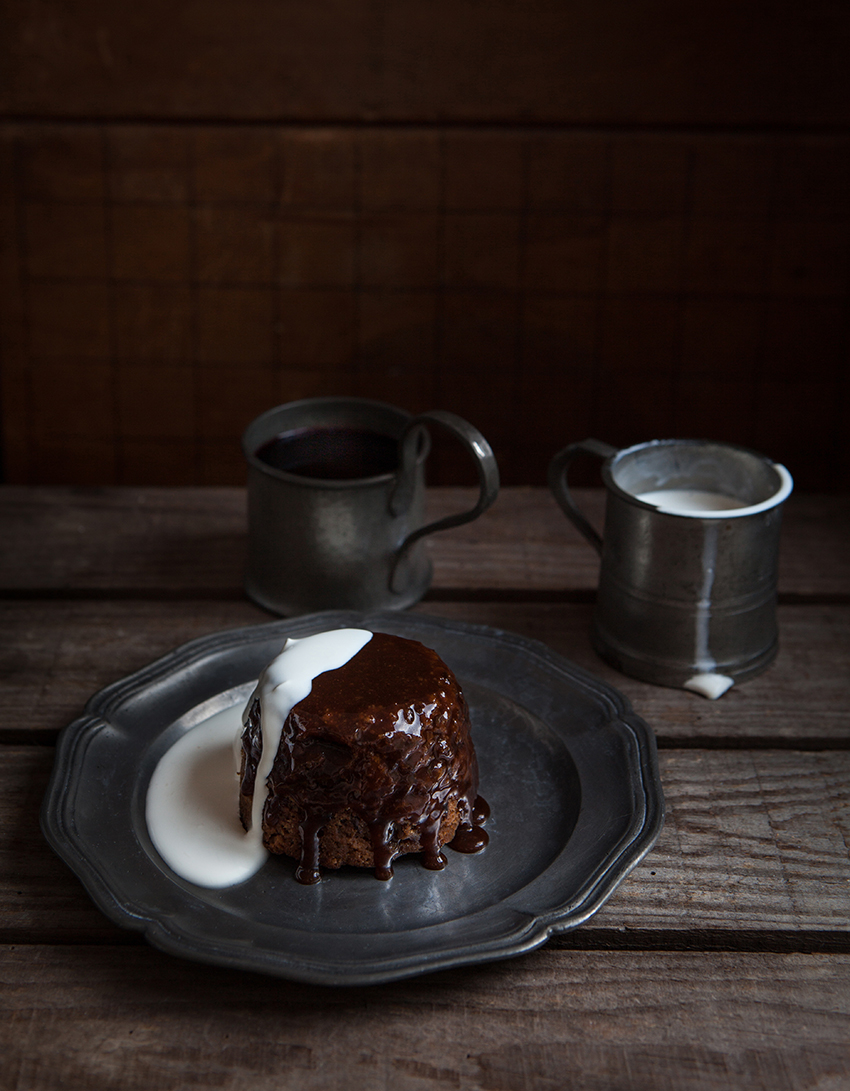 Although I’m now one of the judges on our very own Bake Off in Belgium, I still miss the Great British Bake Off on my television screen every week around this time. As we can only get BBC 1&2, Bake Off has been off-limits to us since its move to Channel 4. GBBO has less viewing figures than when it aired on BBC, that’s partly because they lost viewers from outside of the UK. It seems however that our ‘series one’ of Bake Off Vlaanderen came at the right moment, everyone who misses GBBO in Belgium can soothe their Bake Off hunger by watching us! (if you want to watch it online, you can by going to this page – go to the films with the word ‘Aflevering’ (episode) and there you need to be filling out some details to count viewing figures, the system asks to create a password an to leave your address, just enter 2000 Antwerp)
Although I’m now one of the judges on our very own Bake Off in Belgium, I still miss the Great British Bake Off on my television screen every week around this time. As we can only get BBC 1&2, Bake Off has been off-limits to us since its move to Channel 4. GBBO has less viewing figures than when it aired on BBC, that’s partly because they lost viewers from outside of the UK. It seems however that our ‘series one’ of Bake Off Vlaanderen came at the right moment, everyone who misses GBBO in Belgium can soothe their Bake Off hunger by watching us! (if you want to watch it online, you can by going to this page – go to the films with the word ‘Aflevering’ (episode) and there you need to be filling out some details to count viewing figures, the system asks to create a password an to leave your address, just enter 2000 Antwerp)
Luckily there is social media to keep me informed of the happenings on GBBO and this morning I heard from the lovely Lia of the Lemon & Vanilla blog that tonights episode will feature pudding week! The bakers task is to make a steamed pudding and because I’ve published a whole tome on pudding – savoury and sweet – (in my book Pride and Pudding) I thought I’d share with you one of my favourite sweet steamed puddings: the sticky toffee pudding.
When going for a nice long walk in the British countryside there’s only one thing I long for and that is a pub meal ended with a sticky toffee pud accompanied by a Whisky. It’s the ultimate pudding to have after good outdoor exercise. This is definitely an occasion where I leave room for pudding. A delightfully light yet heavy steamed bit of cake batter, always in a pudding basin, never in the shape of a log please, drowned in custard or with a side of vanilla ice cream which is essentially frozen custard anyway.
Many puddings are surrounded by legends and this is one of them. It is said that the sticky toffee pudding was invented in the 1960s by Francis Coulson of the Sharrow Bay Hotel by the majestic Ullswater lake in the Lake District. He called it an ‘icky sticky toffee sponge’….
Summer Pudding
There’s a lot going on in life but I wanted to share this recipe with you because I find when things get too busy or too complicated, an easy yet satisfying pudding can work like a drink of ice cold water on a scorching hot day. What also prompted me was something my friend Sarah (you might remember her from the pies she made for my launch) showed me online, a link to the making of a summer pudding which created outrage and disgust in the comments section. Foreigners (non-Brits) didn’t understand why you would eat soggy bread with fruit, and the video that came with it made even my stomach turn…
But the fact is that Summer Pudding is one of life’s great things. Bread soaked in fruit juice takes me right back to my childhood. I was a very picky eater but you could always feed me bread topped with mashed up strawberries, the deep red juices seeping into the bread making it hard to get it to your mouth in one piece. It was messy eating but really the only thing I enjoyed to eat.
But what is this heavenly thing you ask if you aren’t British or a pudding nut like I am?
A summer pudding is a delightfully light pudding which is made by lining a pudding basin or charlotte mould with stale white bread slices, then filling it up with lightly stewed summer fruits and topping it off with a juice-soaked bread lid. I always enjoy unmoulding this pudding, to see how the white slices of bread have been tinted by the deep crimson juice. It looks like a fresh red wine stain on a crisp white tablecloth. When ready to indulge, serve with cream, or ice cream, whichever you prefer….
Jumbles on the battlefield
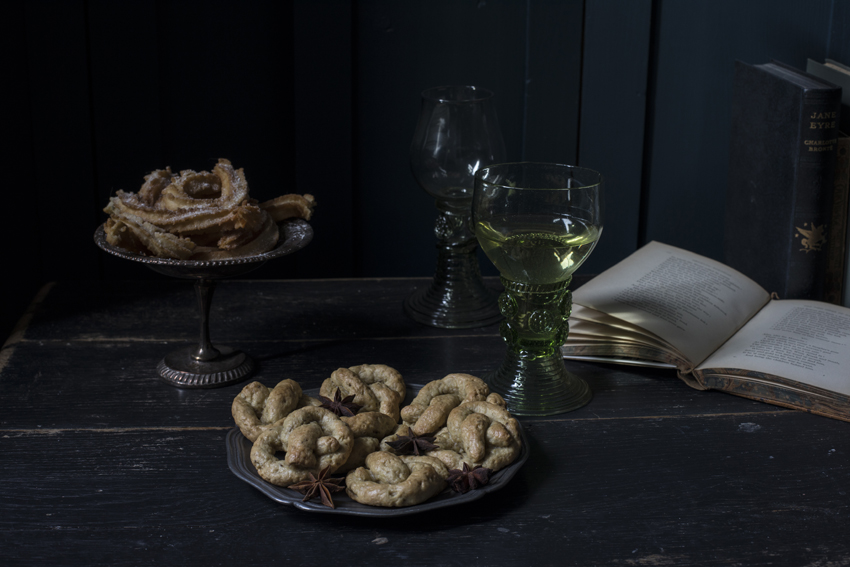 It has been a busy few months, flying from photography assignments and meetings in London to Latvia for research, London again, then to New York, two days after to Milan, then London again, then Milan again a few days ago. I have been spreading myself too thin, so over the Easter weekend, my first weekend home since somewhere in februari, I barricaded myself onto the sofa between stacks of pillows and two sleepy cats.
It has been a busy few months, flying from photography assignments and meetings in London to Latvia for research, London again, then to New York, two days after to Milan, then London again, then Milan again a few days ago. I have been spreading myself too thin, so over the Easter weekend, my first weekend home since somewhere in februari, I barricaded myself onto the sofa between stacks of pillows and two sleepy cats.
We are talking Jumbles today and I don’t mean gibberish.
I was following ‘A History of Royal Food and Feasting’, a fun free online course from the University of reading and Historic Royal Palaces with a lot of interesting historical information about food. A lot of the information I already knew but I did manage to learn a few things, plus it was just great fun to do and force myself to take some rest while still being productive. One of the dishes that were recommended to try on the course were Jumbles, a biscuit I had been meaning to bake but haven’t had the time in my mad schedule. When the Learning and Engagement department got in touch to check if I wanted to get involved to spread the word about the course I of course said yes because I enjoyed it. So Jumbles it was!
Jumbles were knot shaped biscuits that first appeared in the wonderful book The good Huswifes Jewell by Thomas Dawson, dating to 1585. But legend places this biscuit right at the heart of The War of the Roses a century before Dawson’s recipe.
For those who are unfamiliar with English history The Wars of the Roses were a series of battles fought in the period of 1455 to 1485 between two rival branches of the royal House of Plantagenet, the House of York and the house of Lancaster – both sporting a rose in their heraldic emblem. Both made a claim for the throne of England. They were a result from the social and financial problems following the Hundred Years’ War. The Lancastrian claimant, Henry Tudor defeated the last king of the House of York, Richard III at Bosworth Field, near Market Bosworth, a market town in Leicestershire. He then married Edward IV’s daughter, Elizabeth of York, to unite the two houses.
And it is precisely on this last battlefield that a new legend was born, at least a few centuries later……
Francatelli’s Queen Victoria and Albert Pudding
Although spring is in the air at times and daffodils are showing their sunny faces hear and there, some days are still reminding us it is still winter. On cold grey days like these the central heating never seems to give enough warmth although the thermometer says otherwise. Baking seems to be the only antidote to dreary weather and puddings might just be the most fitting with their warming and filling character.
Puddings it is and although I have just published a 378 page book on the history of pudding… which was recently shortlisted for a prestigious André Simon Award (still pinching myself, and although I didn’t win, I am still chuffed to bits!), there are still so many pudding recipes left to boil, bake, steam, fry or freeze. Today I’m taking you to the Victorian era, when puddings were at the height of their splendour.
During Queen Victoria’s reign Britain was going through a period of industrial evolution and urbanisation. It was also a period of peace and stability. The 19th century saw the birth of the rail network with the steam locomotive as the greatest invention. This made for an enormous change in farming as food could now be transported to the towns more quickly and efficiently. On the land a lot of jobs had been replaced by new farming machines, techniques changed, unemployment and poverty rose as the population almost doubled. With more people moving to cities in search for work, demand for produce was high.
The contrast between the lives of the working class and the splendour in which the Queen lived was enormous. Victoria became queen in 1837 at the age of 18 but before that she lived in Kensington Palace which was at that time in quite a state of disrepair.
We know her mostly from her iconic photograph, in profile, dressed in black mourning clothes, looking stern and cold. She is the matriarch, the embodiment of a strong and powerful woman. But in reality she mourned the death of Prince Albert for the rest of her life and found it hard without him.
To know the story behind the portrait, the story of the woman, the queen and the widow, we were treated to an historical drama titled simply ‘Victoria’ recently. And this is the reason for this posting today. ‘Victoria’ is airing in America in March and that is why for the launch TV station KCTS9 and author Laurel Nattress asked me to recreate a pudding for Victoria and her husband Albert from a recipe by the queen’s then chef Charles Elmé Francatelli….
Quince tart and our workshop in Dorset
Two weeks ago on a frosty yet sunny winter morning, we welcomed our workshop attendees at All Hallows Cookery School in Dorset. We started with tea and mini mince pies plus pancakes from the AGA for the early birds. It was hard to get started because we were all having so much fun getting to know each other, or catching up. We made the more delicate puddings from my book, a sweetmeat pudding – otherwise known as the Bakewell pudding, Snake fritters and a quince tart with intricate pastry work. Lunch was beef with prunes, lovingly prepared by our host and owner of the school Lisa Osman. I can’t think of a dish more fitting on a day of English cooking. After all, beef and pudding have been the icon of English food for many centuries. There was a time during the Napoleonic war when eating roast beef and plum pudding would have showed your patriotism. Visitors from all over Europe spoke with high regard about the quality of English meat and beef especially.
After our rather festive lunch in Lisa’s beautiful dining room which made me feel as if I was in a Jane Austen novel, she taught us wreath making which sounds far more easy than it actually was. We struggled and have a huge respect for wreath makers now. We all concluded we now understood why a impressive wreath is so pricy. It takes a ton of work, and will leave you with very painful hands. I finished mine at home and now have it on my front door for all to see….

